Pros: Powerful and efficient hybrids; class-leading space; well-executed tech; distinctive design choices; low prices
Cons: Slow and inefficient base engine; no Hybrid X-Line or X-Pro; X-Pro’s firm ride
The 2024 Kia Sportage Hybrid is a compact SUV that’s tough to beat. After bursting onto the scene last year with a radical redesign that included much bigger dimensions, multiple hybrids and top-notch tech, we quickly concluded it was a class leader. A comparison test between it and the also-redesigned Honda CR-V hybrid ultimately resulted in the smallest of victories for the Honda, but our ratings still count up to 9s for both. That the once-humble Sportage can now stand toe-to-toe with the wildly popular CR-V is a big deal.
Now, you will note that we wrote “Kia Sportage Hybrid” up there. That’s because the non-hybrid base version’s engine is slow, unrefined and inefficient, especially with all-wheel drive. We therefore don’t recommend that, but given the Hybrid costs only $1,200 and represents a performance upgrade as well as a fuel efficiency one, that seems A-OK to us. The fact you can’t get the stylish X-Line trim or quasi-rugged X-Pro with the hybrid is a bummer, though. The Sportage Plug-in Hybrid is only available as the X-Line, curiously, so at least there’s that. And speaking of which, the Sportage PHEV is a similarly great choice, providing 34 miles of all-electric range that should make gas station visits a rarity.
In total, the Sportage delivers distinctive style, excellent infotainment and safety tech, better-than-average value, and best-in-class cargo space. The back seat is vast, too. Despite all this, the Sportage typically costs less (sometimes by several thousands) than a comparable Honda CR-V and Toyota RAV4. We’d still suggest checking out those, especially if for some reason you don’t want a hybrid, along with the mechanically related Hyundai Tucson that offers most of the same benefits (and demerits) with different style.
Interior & Technology | Passenger & Cargo Space | Performance & Fuel Economy
What it's like to drive | Pricing & Trim Levels | Crash Ratings & Safety Features
What's new for 2024?
After being all-new last year, the Sportage heads into 2024 with two minor but substantive changes: rear side airbags and LED headlights are now standard, improving its safety standing even further.
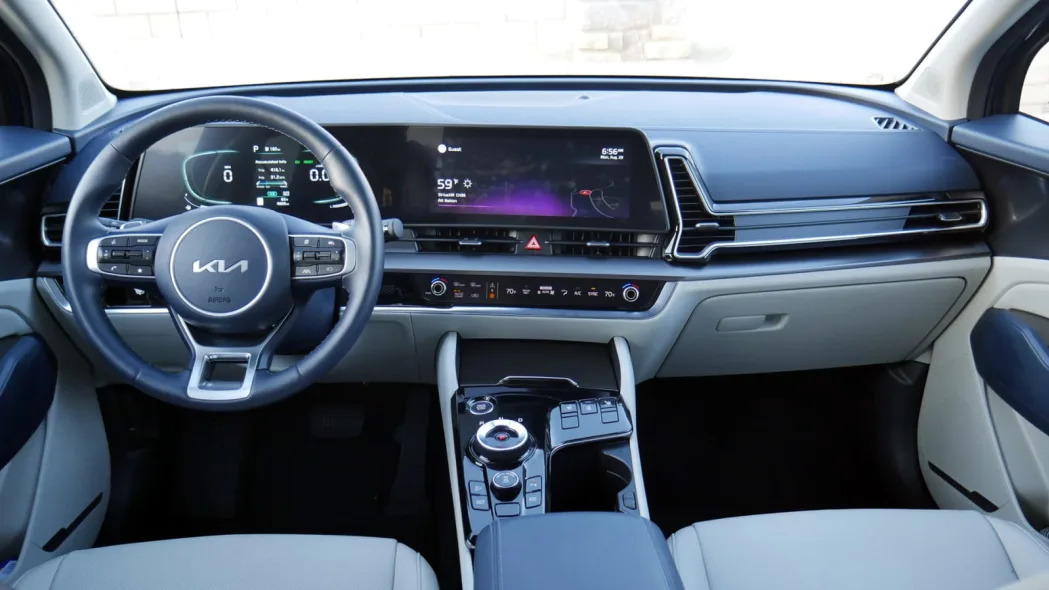
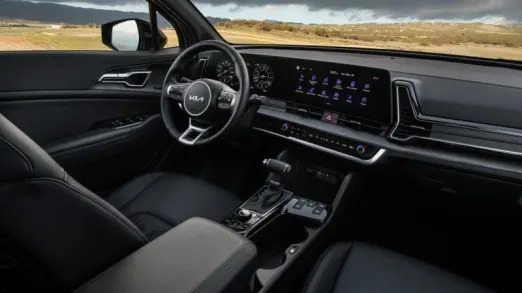

What are the Sportage interior and in-car technology like?
The Sportage interior represents an advantage over most in the segment. In short, it’s cool. There’s a sense of style here you’re not going to find in a RAV4 or Forester. Beyond the design, there are red, navy and sage green interiors available depending on trim level and drivetrain, with even the EX Hybrid eligible for a particularly cool Misty Gray and Triton Navy combo (pictured above). We really like that Kia includes such aesthetic options along with Kia’s usual generous feature content on lower trim levels rather than keeping them exclusive to high-dollar ones. Note that the only interior difference between the hybrid and non-hybrid Sportages is the shifter design (the hybrids get an electronic rotary selector) as well as the available gauge design options.
All powertrains are eligible for the cabin’s main attraction: the giant curved panel housing twin 12.3-inch displays that are shared with the EV6. Found on every trim but the LX, it’s not only an eye-catcher for its curved design and pretty graphics, but like other Kias, the infotainment touchscreen is easy to use. The instrument panel provides crisp, vibrant graphics and a choice of designs that thankfully don't overwhelm you with questionably useful information. Also coming over from the EV6 is the unique row of touch-capacitive “buttons” that serve double duty as climate controls and infotainment menu shortcuts (note that the defrost and recirculation "buttons" always remain in place). It is a departure from Kia’s usual ultra-functional cabin controls and are indeed polarizing: After thousands of miles spent in the similarly equipped EV6 and Kia Niro, some of our editors remain annoyed by them while others aren't bothered at all. The main difference in opinion comes down to how often you adjust the climate controls. All at least agree that they provide a clean look, and we're definitely seeing A LOT worse these days.


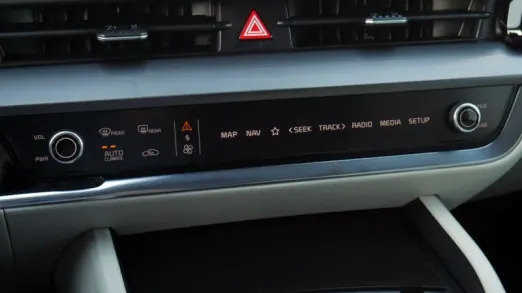

How big is the Sportage?
In short, it’s the biggest. At least in its segment, which admittedly stretches the definition of “compact SUV” … literally. Cargo capacity in particular is a segment-best 39.6 cubic-feet with the back seat up and the dual-level cargo floor in its lower position. The Sportage Plug-In Hybrid does not have that dual-level floor, nor the spare tire underneath, so its maximum is 34.5 cubic-feet, a number that still exceeds most in the segment. Our cargo testing backed that up.
The back seat is also a class-leader with 41.3 inches of legroom. It really is as vast as that spec and the below photo indicates. We had no problem comfortably sitting in front of a rear-facing child seat, and also appreciated the ample amount of rear seat recline.
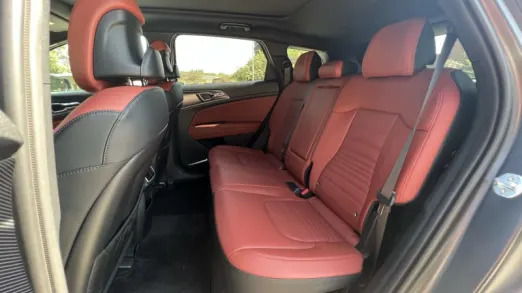

What are the Sportage fuel economy, range and performance specs?
The base engine is effectively average for the segment: a 2.5-liter inline-four that produces 187 horsepower and 178 pound-feet of torque. It’s attached to an eight-speed automatic (many competitors have a less desirable CVT), and a choice of front- or all-wheel drive. Fuel economy is an EPA-estimated 25 mpg city, 33 mpg highway and 28 mpg combined with FWD, and 23/26/25 with AWD. That latter number is just not good, especially on the highway. We also don’t understand how the X-Pro, which has all-terrain tires, actually has a better highway number: 23/30/26. Either way, most competitors do considerably better (the CR-V AWD gets 29 mpg combined).
The Sportage Hybrid is therefore highly recommended. This unique combination of 1.6-liter turbocharged inline-four, electric motor and six-speed automatic pairs with either front- or all-wheel drive. Together it produces 227 hp and 258 lb-ft of torque, a robust amount that is far more than other hybrids and in keeping with the turbocharged, gas-only engine upgrades of rival SUVs. It returns 42 mpg city, 44 mpg highway and 43 mpg combined with FWD and 38/38/38 with AWD. That’ll in theory save you hundreds of dollars every year on gas, but in several hundred miles of mixed driving, we only managed 32 mpg combined with an AWD EX.
The Sportage Plug-In Hybrid builds upon the conventional hybrid with a much larger battery. All-wheel drive is standard. It produces 261 hp and 258 lb-ft. After plugging the car in and with a full battery, the PHEV will go an EPA-estimated 34 miles on electricity alone. Even if you can’t plug in, it’ll still return 35 mpg combined. Using a Level 2 home charger, it'll take about 2 hours to recharge the battery, which is quick for a PHEV.
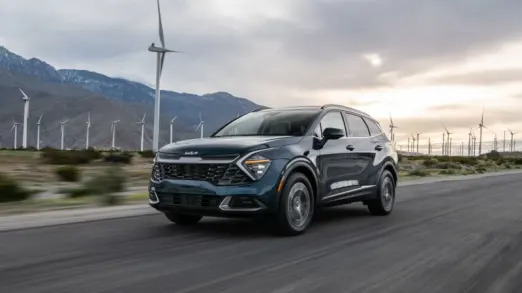
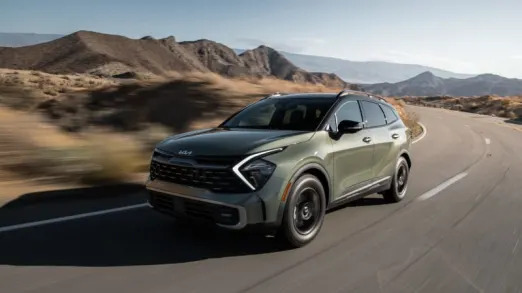
What's the Sportage like to drive?
While most of its competitors offer a choice of either a hybrid powertrain or a higher-performance engine upgrade, the Sportage offers up something that does both: the Hybrid. Considering it only costs $1,200 more than the base engine, it makes your decision even easier. Besides blowing the hybrid competition away in terms of power, the Sportage Hybrid’s conventional transmission and turbocharged engine provide a far more normal and quiet driving experience. And compared to the gutless base 2.5-liter, the turbo-plus-electric-motor combo makes it feel notably gutsier around town and when passing and, despite the small-displacement engine, is quieter when you punch the throttle.
The Sportage Plug-In Hybrid, meanwhile, is generally very similar to the regular Hybrid. Even when powered by electricity alone, the car shifts gears, which is weird if you've driven EVs or other plug-in hybrids, but totally normal if you haven't. As with other PHEVs, though, you can select to some extent how the wheels are powered. The EV drive mode will drive as the name suggests, but acceleration feels considerably pokier than a full EV like Kia's Niro or EV6. Giving the throttle a good whack will in fact engage the engine to make sure you can really get going if and when you need too. The HEV drive mode will more readily fire the engine, but still prioritizes the electric range when available. Honestly, it sounds more complicated than it is.
Moving beyond the engines, driving the Sportage is typical for a Kia: competent, vice-free and largely forgettable. It handles well enough and the ride is comfortable enough. Want something sharper? Try a Mazda CX-50, Honda CR-V or Toyota RAV4 Hybrid SE. Want something more rugged? Well, the Sportage has an answer for that. First, there’s the X-Line, which is really just an appearance package. It's available with the base engine or the plug-in hybrid. The X-Pro builds upon that with B.F. Goodrich all-terrain tires, 17-inch matte black wheels and recalibrated drive mode settings for reduced traction conditions. Oh, and a black roof. It has the same 8.3 inches of ground clearance as every other all-wheel-drive Sportage, however. That’s not insignificant, but it’s less than the RAV4 TRD Off-Road, Jeep Cherokee Trailhawk and every Subaru Forester, including the sky-high Wilderness. If you really want to get dirty, get one of those first. If not, know that you’ll be saddled with the less desirable base engine and those all-terrain tires that produce a firmer and jigglier ride, more road noise and a degradation of road holding. The X-Pro would definitely not be our first choice.
What other Kia Sportage reviews can I read?
Comparison Test: Kia Sportage Hybrid vs Honda CR-V Sport Touring
In this comparison test between our two top-rated compact SUVs, the Sportage comes in a very close second.
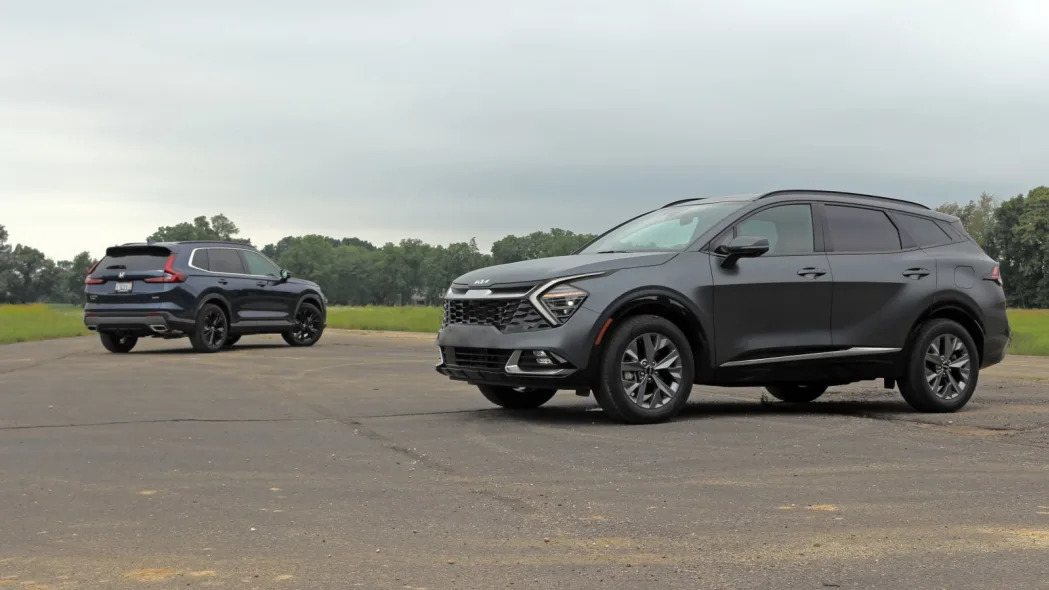
2023 Kia Sportage First Drive Review: Bigger, greener, off-roadier
Dig deeper into the changes for the Sportage compared to its predecessor, plus what you can expect from the X-Pro both on road and off-road.
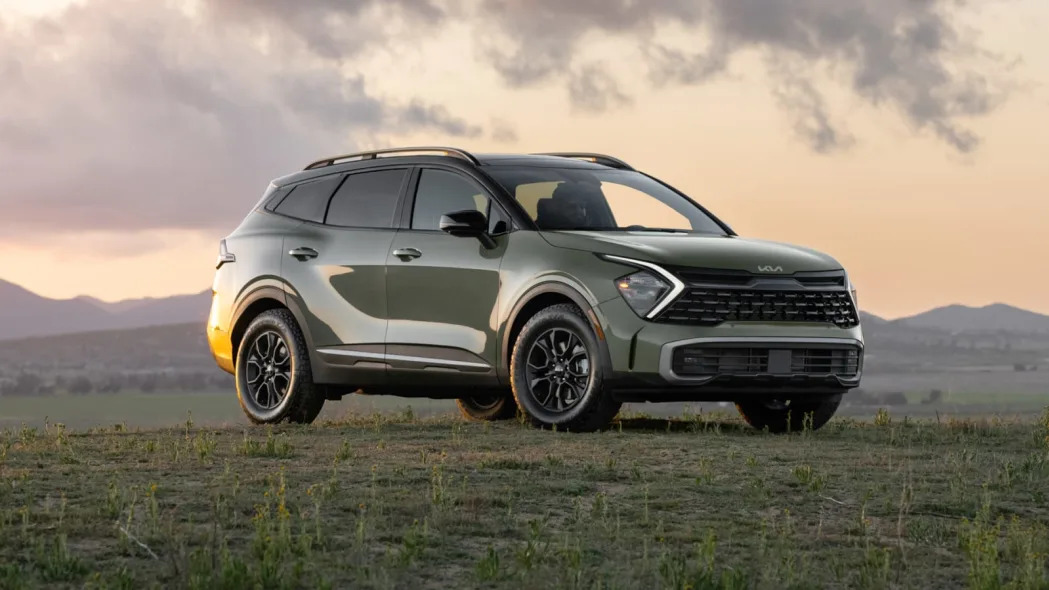
Kia Sportage Luggage Test
The specs say the Sportage has best-in-class cargo capacity behind its back seat. We put the numbers to the test.
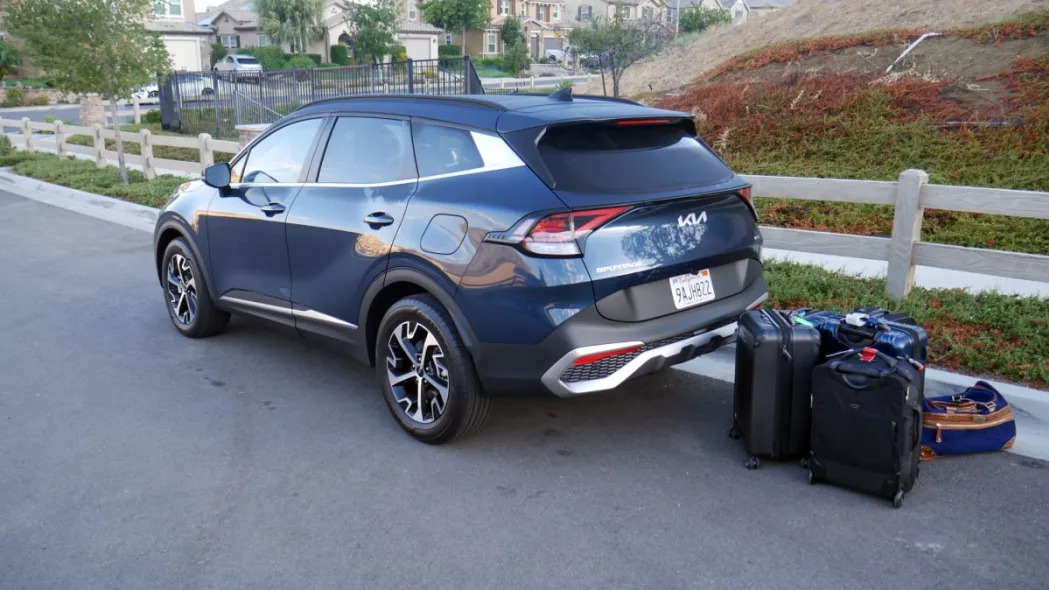
What is the 2024 Sportage price?
Pricing starts at $28,415, including the $1,325 destination charge, which is less than the Honda CR-V and Toyota RAV4 despite comparable equipment. The Hybrid’s pricing is even better, starting at $29,615, which undercuts the CR-V hybrid by $5,000 and the RAV4 Hybrid by $3,000.
Despite that low base price, we thinking shelling out an extra $2,000 for the EX would be a good idea given all the extra stuff you get: power driver seat, heated front seats, synthetic leather upholstery, a real-leather wheel, dual-zone climate control, proximity key and push-button start, blind-spot warning, wireless charging and perhaps most notably, the 12.3-inch touchscreen encased in that super-cool curved display casing.
From there, the SX just looks sportier while adding a few token niceties like that curved display casing. The X-Line gets different bumpers, gloss black trim, exclusive wheels, raised roof rails and a tread-like pattern in its synthetic leather upholstery. It's the only trim level that can be paired with the Sportage Plug-In Hybrid, which is odd since you can’t pair that trim with the regular hybrid at all. Basically, it looks more rugged, but functionally isn’t. The X Pro is, though only to an extent. It gets B.F. Goodrich all-terrain tires, 17-inch matte black wheels and recalibrated drive mode settings for reduced traction condition.
All prices below include the $1,325 destination.
2.5-liter base engine
LX: $28,415
LX AWD: $30,215
EX: $30,415
EX AWD: $32,215
SX: $33,915
SX Prestige: $35,915
SX Prestige AWD: $35,915
X-Line AWD: $33,215
X-Pro AWD: $37,415
X-Pro Prestige: $39,215
Hybrid
LX: $29,615
LX AWD: $31,415
EX AWD: $33,315
SX Prestige AWD: $38,515
PHEV
X-Line AWD: $40,815
X-Line Prestige AWD: $45,315
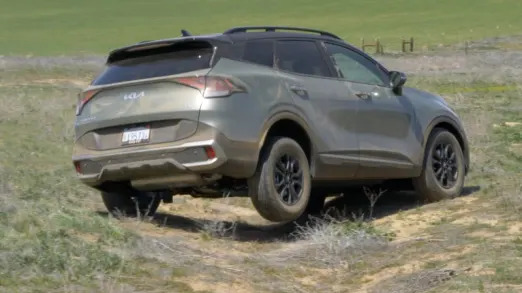
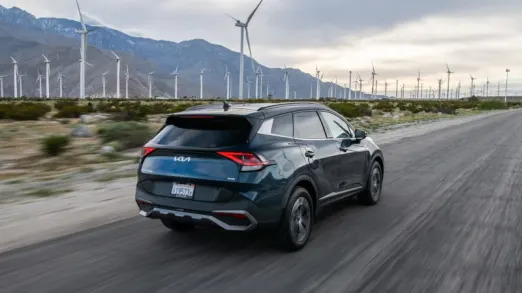
X-Pro and Hybrid EX AWD
What are the Sportage safety ratings and driver assistance features?
Every 2024 Sportage includes as standard forward collision warning with pedestrian and cyclist detection, automatic emergency braking, lane-keeping assist, lane-departure warning, rear parking sensors and a driver inattention warning system. It also comes standard rear side airbags, which is rare. All trim levels but the LX gain blind-spot and rear cross-traffic warning, and the Safe Exit Warning that uses the first two systems to warn occupants to not open their door in the event of cars or cyclists coming from the rear. Kia’s excellent Highway Driving Assist adaptive cruise control system with lane-centering steering assist is included on the SX and X-Pro trim levels.
The Insurance Institute for Highway Safety named the Sportage a Top Safety Pick+ last year after it got top marks in all pertinent crashworthiness and crash prevention categories but one: headlights. That was a second-best “Acceptable” score, which could explain why Kia upgraded the headlights for 2024.
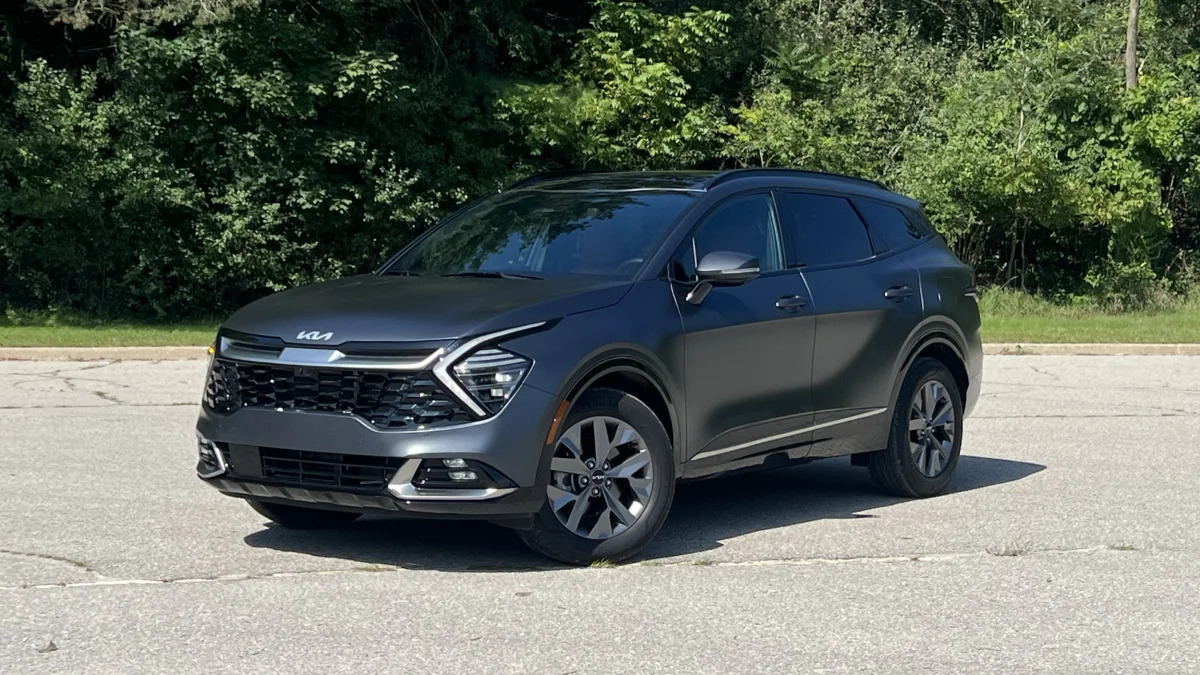









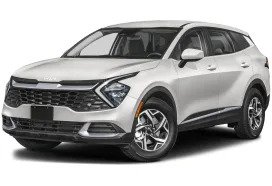

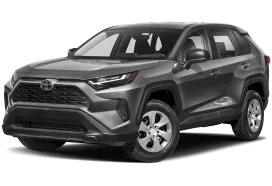

Sign in to post
Please sign in to leave a comment.
Continue